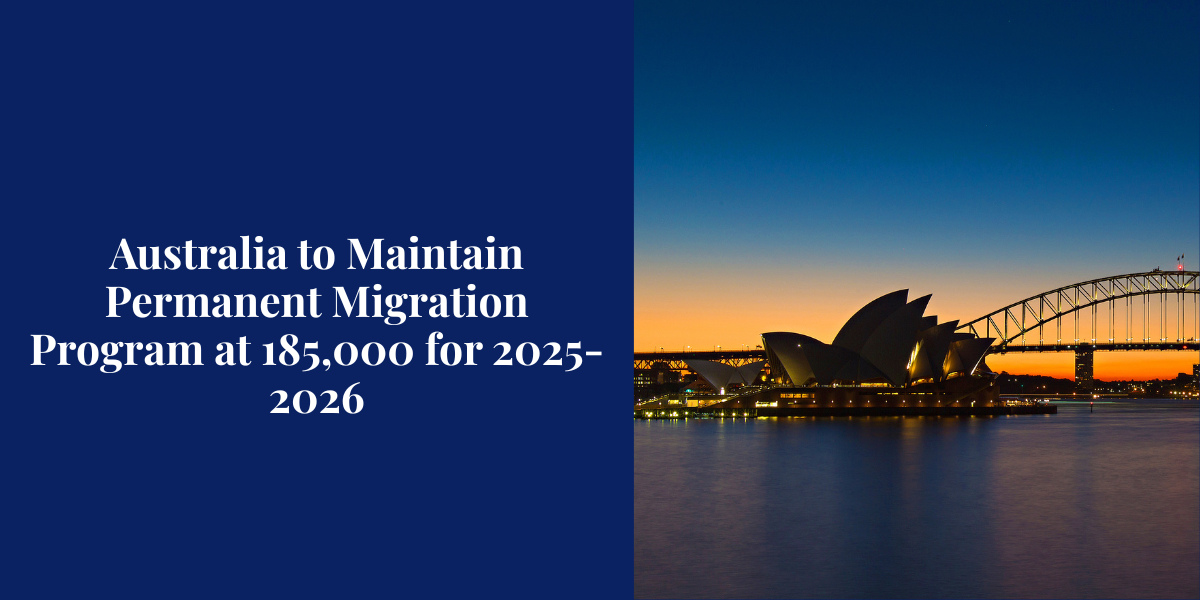
In a move welcomed by the Migration Institute of Australia (MIA), the Australian Government has decided to maintain the permanent migration planning level at 185,000 places for the 2025-2026 financial year. This decision reflects a balanced approach to addressing key priorities such as workforce shortages, family reunification, population ageing, and sustainable migration. According to Peter van Vliet, CEO of the MIA, this is “a good sign for employers and businesses” and “for Australian citizens wishing to reunite with their loved ones.”
Why 185,000 Places this Year?
Here are the major reasons:
Addressing Skills Shortages
The Australian labour market continues to endure shortages in essential sectors from healthcare and engineering to hospitality and technology. The Employer Sponsored visa stream, a key component of the permanent migration program, ensures businesses can access overseas specialists to fill critical roles.
Supporting Economic Growth and Tax Revenue
Qualified permanent migrants contribute not only to the workforce but also to tax revenues and broader economic productivity. As the MIA notes, "maintaining the current permanent migration planning level enhances business confidence in addressing skills shortage”.
Mitigating Population Ageing
Like many developed nations, Australia faces demographic challenges including low birth rates and an ageing population. Sustainable migration helps balance this trend, infusing the workforce with younger, working-age individuals.
Family Reunion Objectives
On top of the economic rationale, there is a social and humanitarian dimension: migration is also about keeping families together. The allocation supports partner and family visa processing, ensuring Australians aren’t unduly separated from loved ones.
Avoiding Policy Whiplash
With net overseas migration projected to return to more typical levels in the coming years, the government opted against reacting hastily. Instead of reducing intake precipitously, maintaining stability offers certainty for businesses and migrant communities
Social Benefits: Community and Reunification
Migration isn’t just about jobs, it is also about people:
- Speeding Up Family Processing: With partner and family visas in the mix, the government helps Australians reunite with spouses and close relatives. This reunification aids community cohesion and supports migrants’ wellbeing.
- Preserving Cultural Diversity: Australia’s reputation as a vibrant multicultural nation owes much to ongoing migration. Maintaining stable intake supports this dynamic, bringing in diverse talents, perspectives, and experiences.
Economic and Fiscal Considerations
Looking beyond qualitative benefits, the migration cap has concrete economic implications:
- GDP Growth: An invigorated workforce contributes directly to economic output. Migrants fill labor gaps, launch businesses, and drive innovation.
- Boosted Tax Revenue: As working‑age migrants enter the job market, they bolster tax collections such as supporting public services, infrastructure, and social programs.
- Cost‑Benefit Equilibrium: Migration is a long-term investment. With adjusted planning levels and robust selection criteria, Australia maximises net economic gain while controlling integration costs.
Managing Population Ageing
One of the more pressing long-term challenges facing Australia is its ageing demographic profile. As birth rates fall and life expectancy rises, the share of older citizens increases, raising the dependency ratio. Here migration plays a critical role:
- Balancing Demographic Composition: The influx of younger migrants helps recalibrate the age structure, ensuring enough working‑age people to support older cohorts.
- Supporting Regional Economies: Many migrants settle outside major urban centers helping revitalize rural and regional areas struggling with population decline.
Challenges in Planning Levels
Of course, maintaining planning levels isn’t without its critics and practical hurdles such as:
- Infrastructure Pressure: Ongoing migration means continual pressure on housing, healthcare, education, and urban infrastructure.
- Visa Processing Strain: While partner and family visa backlogs have lessened recently, stable intake ensures processing won’t be disrupted.
- Public Sentiment: Migration policy remains politically sensitive. The government must balance economic imperatives with public concerns around integration and environmental impact.
- Regional vs Urban Split: Ensuring new migrants don’t cluster only in major cities is critical. Effective regional settlement strategies and support mechanisms are needed.
Conclusion
With the 2025–26 permanent migration level set at 185,000 places, attention now turns to how this figure will be distributed across key migration streams. Skilled Migration will remain the dominant category, with employer-sponsored and independent skilled visas taking center stage to address Australia’s workforce needs. Family Reunification continues to be a priority, with allocations for partner visas that enable Australian citizens and permanent residents to reunite with their loved ones. The Special Eligibility stream will cater to exceptional cases, including former residents, individuals on humanitarian grounds, and refugee status holders.
In addition to these allocations, policymakers are focusing on further enhancing the program’s effectiveness. Regional migration incentives are being considered to encourage migrants to settle outside major metropolitan areas, supporting balanced population growth. Processing modernisation is also on the agenda, with planned investments in digital infrastructure and additional staffing to reduce visa processing times. Lastly, skills alignment will play a crucial role in targeting occupations experiencing national shortages, ensuring that the migration program continues to support Australia’s long-term economic and labour market goals.
Contact Cross Border Education
Cross Border Education is the best immigration consultant in India. With a proven track record of successful Australian PR applications, personalized consultation, and up-to-date visa knowledge, our team ensures your migration journey is smooth and stress-free.


